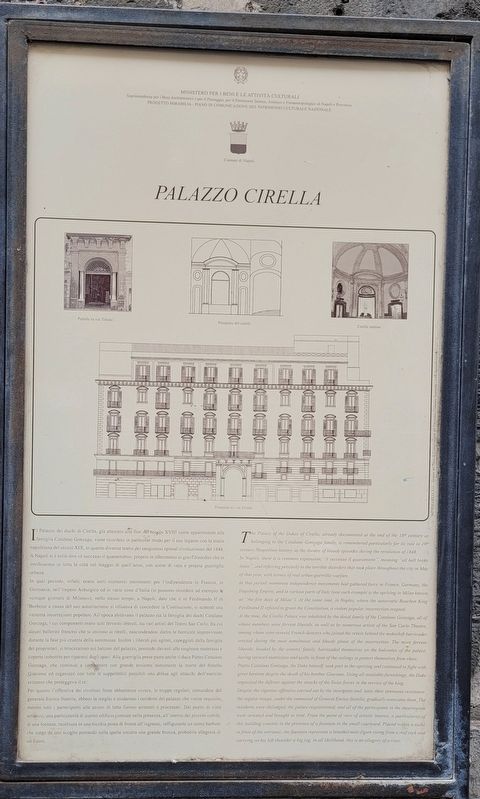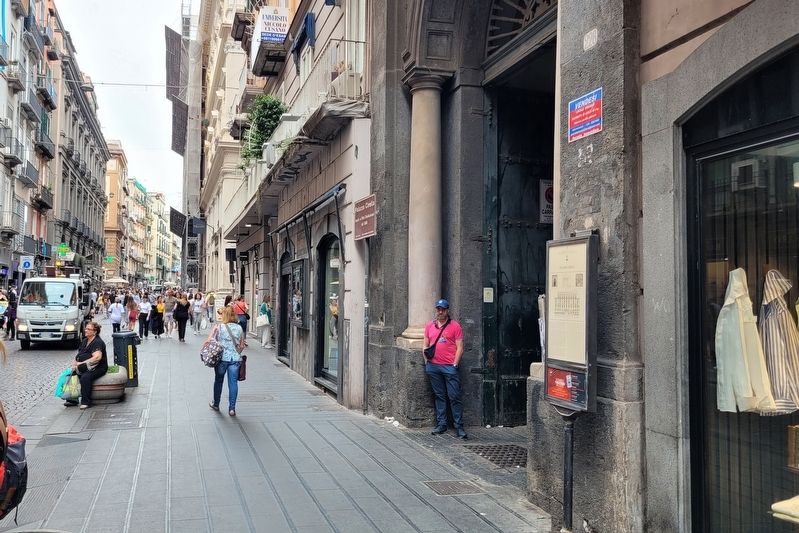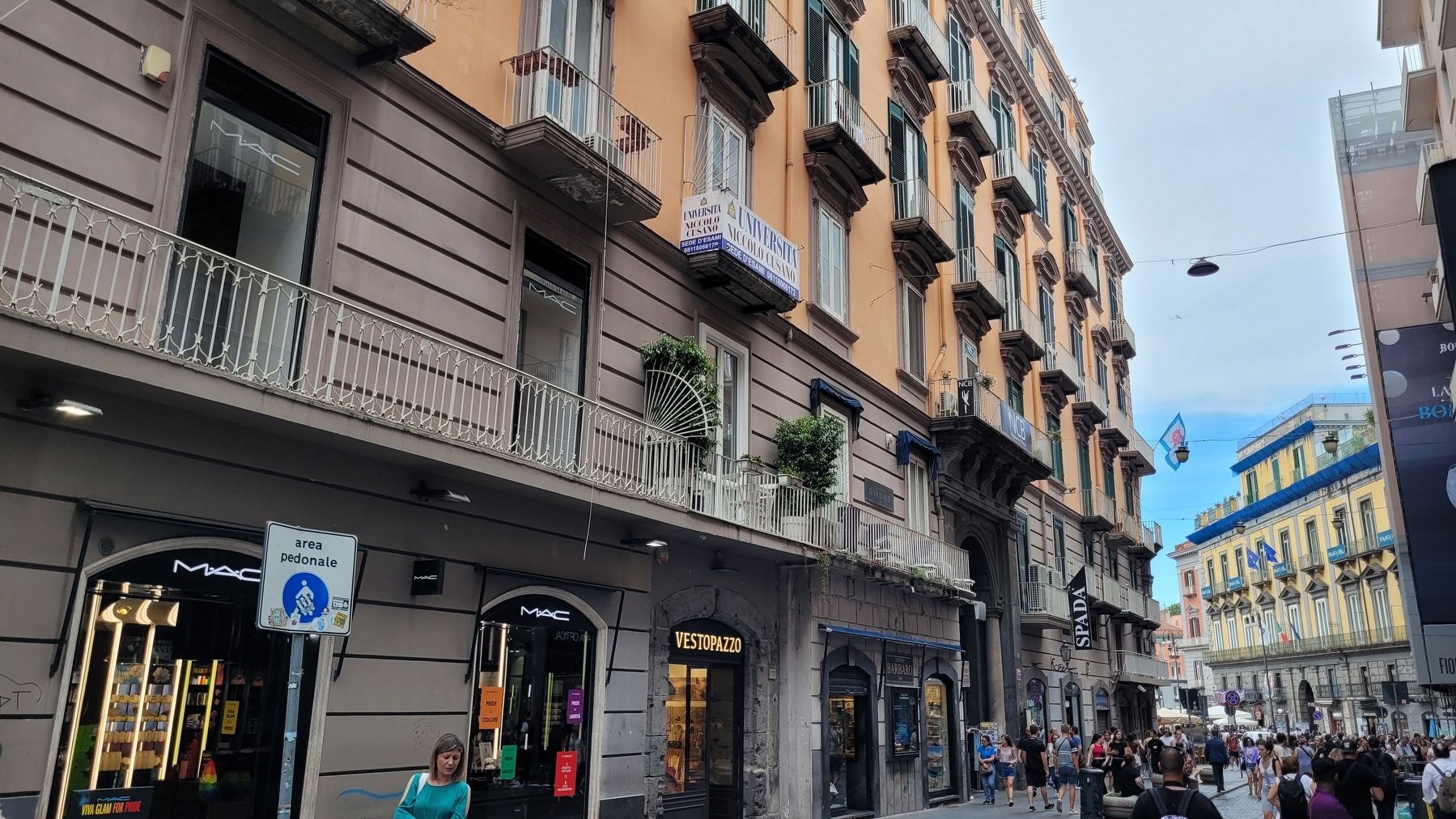Royal Naples in Napoli in Città Metropolitana di Napoli, Campania, Italy — Southern Italy (Tyrrhenian Coast)
Palazzo Cirella / Cirella Palace
In quel periodo, infatti, erano sorti numerosi movimenti per l'indipendenza in Francia, in Germania, nell'Impero Asburgico ed in varie zone d'Italia (si possono ricordare ad esempio le "cinque giornate di Milano"); nello stesso tempo, a Napoli, dato che il re Ferdinando II di Borbone a causa del suo autoritarismo si rifiutava di concedere la Costituzione, si scateno una violenta insurrezione popolare. All'epoca abitavano il palazzo sia la famiglia dei duchi Catalano Gonzaga, i cui componenti erano tutti ferventi liberali, sia vari artisti del Teatro San Carlo, fra cui alcuni ballerini francesi che si unirono ai ribelli, nascondendosi dietro le barricate improvvisate durante la fase più cruenta della sommossa. Inoltre i liberali più agitati, capeggiati dalla famiglia dei proprietari, si trincerarono sui balconi del palazzo, ponendo davanti alle ringhiere materassi e coperte imbottite per ripararsi dagli spari. Alla guerriglia prese parte anche il duca Pietro Catalano Gonzaga, che continuò a combattere con grande eroismo nonostante la morte del fratello Giacomo ed organizzò con tutte le suppellettili possibili una difesa agli attacchi dell'esercito svizzero che proteggeva il re.
Per quanto l'offensiva dei rivoltosi fosse abbastanza vivace, le truppe regolari, comandate dal generale Enrico Statella, ebbero la meglio e snidarono i residenti del palazzo che venne requisito, mentre tutti i partecipanti alle azioni di lotta furono arrestati e processati. Dal punto di vista artistico, una particolarità di questo edificio consiste nella presenza, all'interno del piccolo cortile, di una fontana, racchiusa in una nicchia posta di fronte all'ingresso, raffigurante un uomo barbuto che sorge da uno scoglio portando sulla spalla sinistra una grande brocca, probabile allegoria di un fiume.
Didascalie
Portale su via Toledo
Prospetto del cortile
Prospetto Toledo interno
Prospetto su via Toledo
The Palace of the Dukes of Cirella,
already documented at the end of the 18th century as belonging to the Catalano Gonzaga family, is remembered particularly for its role in 19th century Neapolitan history, as the theatre of bloody episodes during the revolution of 1848. In Naples, there is a common expression, "è successo il quarantotto", meaning "all hell broke loose", and referring precisely to the terrible disorders that took place throughout the city in May of that year, with scenes of real urban guerrilla warfare.
In that period, numerous independence movements had gathered force in France, Germany, the Hapsburg Empire, and in various parts of Italy (one such example is the uprising in Milan known as "the five days of Milan"). At the same time, in Naples, where the autocratic Bourbon King Ferdinand II refused to grant the Constitution, a violent popular insurrection erupted.
At the time, the Cirella Palace was inhabited by the ducal family of the Catalano Gonzaga, all of whose members were fervent liberals, as well as by numerous artists of the San Carlo Theatre, among whom were several French dancers who joined the rebels behind the makeshift barricades erected during the most tumultuous and bloody phase of the insurrection. The more fervent liberals, headed by the owners family, barricaded themselves on the balconies of the palace, having secured mattresses and quilts in front of the
railings to protect themselves from shots. Pietro Catalano Gonzaga, the Duke himself, took part in the uprising and continued to fight with great heroism despite the death of his brother Giacomo. Using all available furnishings, the Duke organized the defence against the attacks of the Swiss forces in the service of the king.
Despite the vigorous offensive carried out by the insurgents and, later, their strenuous resistance, the regular troops, under the command of General Enrico Statella, gradually overcame them. The residents were dislodged, the palace requisitioned, and all of the participants in the insurrection were arrested and brought to trial. From the point of view of artistic interest, a particularity of this building consists in the presence of a fountain in the small courtyard. Placed within a niche in front of the entrance, the fountain represents a bearded male figure rising from a reef rock and carrying on his left shoulder a big jug. In all likelihood, this is an allegory of a river.
Captions
Portal on via Toledo
Front view of the courtyard
Internal Toledo elevation
Prospectus on via Toledo
Erected by Ministero Per I Beni E Le Attività Culturali, Soprintendenza per i Beni Architettonici e per il Paesaggio, per il Patrimonio Storico Artistico e Demoetnoantropologico di Napoli e Provincia, Progetto Mirabilia Piano di Comunicazione del Patrimonio Culturale Nazionale and Comune di Napoli.
Topics. This historical marker is listed in these topic lists: Architecture • Wars, Non-US. A significant historical year for this entry is 1848.
Location. 40° 50.293′ N, 14° 14.907′ E. Marker is in Napoli, Campania, in Città Metropolitana di Napoli. It is in Royal Naples. Marker is at the intersection of Via Toledo and Via Sergente Maggiore, on the right when traveling north on Via Toledo. The marker is located on the right side of the front entrance to the Palazzo. Touch for map. Marker is at or near this postal address: Via Toledo 228, Napoli, Campania 80132, Italy. Touch for directions.
Other nearby markers. At least 8 other markers are within walking distance of this marker. Palazzo Berio / Berio Palace (within shouting distance of this marker); Galleria Umberto I (within shouting distance of this marker); Chiesa di S. Ferdinando / Church of S. Ferdinando (about 90 meters away, measured in a direct line); Palazzo Salerno e Gambrinus / Salerno and Gambrinus Palace (about 120 meters away); Il Caffè Sospeso / The Suspended Coffee (about 150 meters away); Palazzo Reale / Royal Palace (about 150 meters away); Palazzo Zevallos Stigliano / Zevallos Stigliano Palace (about 180 meters away); Basilica di S. Francesco di Paola / Basilica of St. Francis of Paola (approx. 0.3 kilometers away). Touch for a list and map of all markers in Napoli.
Credits. This page was last revised on July 17, 2023. It was originally submitted on July 16, 2023, by James Hulse of Medina, Texas. This page has been viewed 68 times since then and 27 times this year. Photos: 1, 2, 3. submitted on July 17, 2023, by James Hulse of Medina, Texas.


